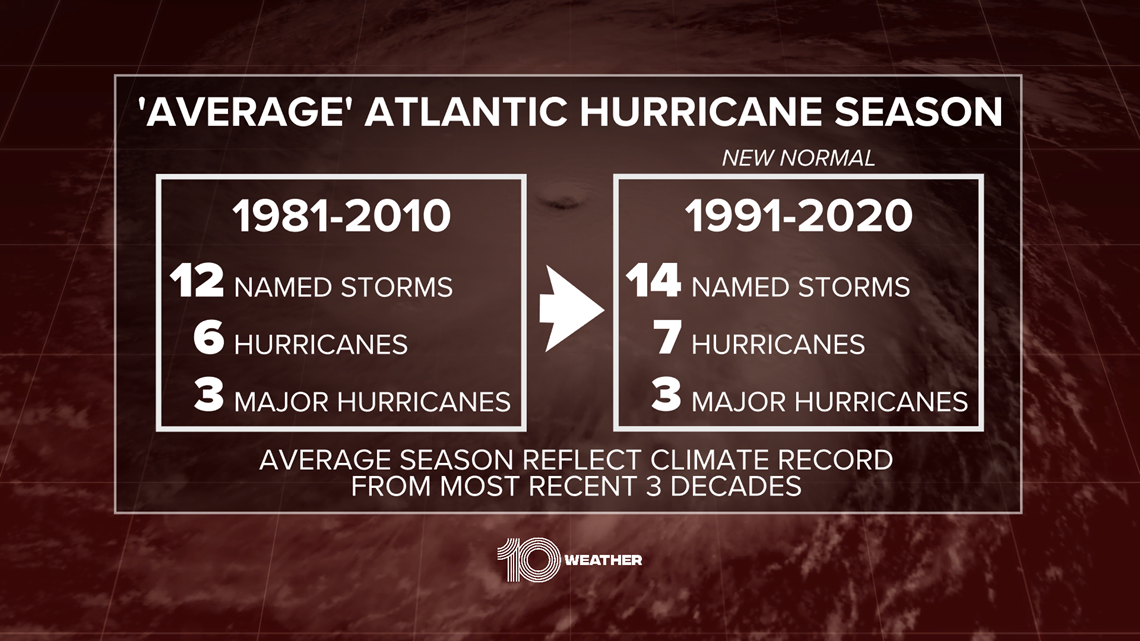TAMPA, Fla. — The National Oceanic and Atmospheric Administration updated the averages for the number of storms the Atlantic hurricane season sees-- and not in the direction you might have hoped for.
The updated averages for the Atlantic hurricane season have increased with 14 named storms and seven hurricanes.
That's up from the previous Atlantic storm averages, based on the period from 1981 to 2010, which were 12 named storms and six hurricanes.
The average for major hurricanes remains at three.
The new average comes as NOAA’s Climate Prediction Center moves on to using 1991-2020 as the new 30-year period of record instead of 1981 to 2010.
The updated statistics help NOAA determine if hurricane seasons are above, near, or below-average relative to the recent climate.
“This update allows our meteorologists to make forecasts for the hurricane season with the most relevant climate statistics taken into consideration,” said Michael Farrar, director of NOAA’s National Centers for Environmental Prediction. “Our work illustrates the value of NOAA’s investments in next-generation technologies to capture the data that underpins our outlooks and other forecast products. These products are essential to providing the public and local emergency managers with advance information to prepare for storms, and achieving NOAA’s mission of protecting life and property.”
NOAA said it updates its statistics once every decade.


So, why more storms?
NOAA says the average could have gone up thanks to the overall improvement in observing platforms, like its NOAA’s fleet of environmental satellites and continued hurricane reconnaissance.
NOAA says a warming ocean and atmosphere which are influenced by climate change can't be ruled out as factors either.
Last year, 10 Tampa Bay Meteorologist Grant Gilmore took a deeper dive into just how much of a role climate change could be playing in the number and strength of storms we see during hurricane season.
Just last year the Atlantic hurricane season was one for the record books.
The season ended with a record 30 named storms. For the second time in history, the National Hurricane Center had to use the Greek alphabet for storm names.
One of those storms, Hurricane Iota, became the latest forming Category 5 hurricane on record to form in the Atlantic on Nov. 16, breaking a record from 1932.
In March 2021, the World Meteorological Organization announced it was dropping the use of the Greek alphabet.
On Thursday, researchers at Colorado State University forecast another busy Atlantic hurricane season for 2021.
The respected hurricane research program at CSU predicts an above-average hurricane season with 17 named storms and eight hurricanes. Of those, they are forecasting eight hurricanes, with four that reach major hurricane strength.
RELATED: Colorado State hurricane experts predict an above-average Atlantic hurricane season in 2021
Hurricane season runs from June 1 through Nov. 30.
What other people are reading right now:
- Getting your second dose of COVID-19 vaccine? Here's what to expect
- Prince Philip, husband of Britain’s Queen Elizabeth II, dead at 99
- Pumping of wastewater from Piney Point put on pause
- Man sentenced to 24 years in prison for killing of mom, baby in 2018 Bayshore crash
- Hurricane experts predict an above-average Atlantic hurricane season in 2021
- Rays Up! Here's everything you need to know about the Tampa Bay Rays home opener today
►Breaking news and weather alerts: Get the free 10 Tampa Bay app
►Stay In the Know! Sign up now for the Brightside Blend Newsletter



